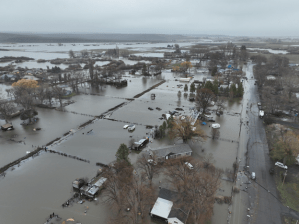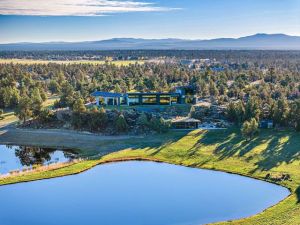Bend overcame air pollution caused by woodstoves, now a new threat has emerged
Published 5:45 am Sunday, April 28, 2024

- Bend Growth Survey QR Code 2024
When wildfire season is at its peak in late summer, Shalee Hanks-Mink is usually up at the crack of dawn. Before coffee, before anything, she is on her phone, checking various apps that display the current air quality readings in the area.
Hanks-Mink isn’t fighting wildfires but as youth recreation supervisor for Bend Park & Recreation District, she must closely monitor smoke levels in the city to determine if outdoor programs have the green light to proceed, must be moved indoors or canceled altogether.
Trending
“The impact is real. It’s the opposite of a snow day. On snow days, everyone is excited to have a day off from school. Smoke days are the opposite for us,” said Hanks-Mink.
Shifting gears during wildfire smoke events has become the new normal for hundreds of families across Bend as they grapple with air pollution events, the likes of which no previous generation needed to consider.
The source of the smoke is occasionally nearby — in the Deschutes or Willamette national forests, caused by prescribed burns or wildfires. But it can come from further afield too. Smoke doesn’t stop at state lines or international borders.
People living in low- and middle-income countries suffer the worst impacts of air pollution, including lung cancer, respiratory diseases and premature birth. But even in the United States an estimated 131 million people live in places with unhealthy levels of ozone or particulate pollution, the American Lung Association reported Wednesday.
Air pollution from wildfires has skyrocketed in Bend since 2017, DEQ says
Trending
Some of the most common air quality pollutants include household fireplaces and woodstoves, vehicle emissions, industrial facilities and forest fires, according to the World Health Organization. While Bend has low levels of the first three, the city and its surrounding towns are adapting to wildfire smoke.
It’s worth saying that during the rest of the year outside of smoke season, the air in Bend is pretty good. But because so much smoke is concentrated during the late summer, the Bend-Prineville area ranks 33rd worst in the United States by annual particle pollution, according to data compiled by the American Lung Association.
Growth leaves more impacted
The population in Bend has doubled over the past two decades. That leaves more people to bear the brunt of the problems caused by smoke, which has increased dramatically since 2017, according to the Department of Environmental Quality.
Those problems typically emerge in August and can persist into September. In recent years during these months, the wildfire smoke has canceled outdoor concerts and closed pools. Restaurants and bars that rely on outdoor seating to attract patrons see a decline in revenue. Golf courses, bike rental shops and nearly anything tourist-related can be impacted.
Katy Brooks, Bend Chamber of Commerce executive director, says the smoke-triggered cancellations create a sudden roadblock for Bend’s economy at a time when many businesses are usually getting into the black for the year.
“Weather events and other natural events such as wildfires have a real impact on businesses related to tourism,” said Brooks. “Many barely made it through this winter because of the ice storms. Similarly, when it gets smoky here tourists choose to leave early and others considering a visit won’t come at all. It’s a very serious issue.”
Children especially affected
Children in particular are impacted because of the amount of time they spend outdoors and the damage that particulate matter can do to developing bodies.
Jessica Hui, a pediatric allergist and immunologist at National Jewish Health in Denver, says there have been more than 100 studies that have looked at the impact of air pollution on children of all age ranges and even those in utero.
“All of them have shown that the exposure they have to air pollution leads to various health problems,” said Hui. “We know the environment is contributing.”
FAQ: Here’s how to manage air pollution when the AQI spikes
Concerns over child health are one reason why Bend-La Pine School District installs MERV 13 filters into school HVAC systems. District spokesperson Scott Maben says the higher-end MERV 13 filters were originally purchased during the COVID era but now also work well to filter out smoke.
The impact of poor air quality goes beyond Bend park district activities. High school athletes have also seen their activities altered. When the air quality index surges to unhealthy levels things can get crowded inside the school. That’s when football, soccer and cross country athletes come indoors, practicing in gyms, weight rooms, hallways or anywhere else they can find a spot.
“When we have to make alterations to our schedules (because of smoke) we just do it, we get the kids playing, get them practicing,” said Dave Williams, athletic director for Caldera High School.
Bend has overcome some air pollution
For Bend’s growing population, navigating this annual problem will continue to be challenging. But Bend has faced similar challenges in the past.
Two decades ago the city suffered wintertime air pollution in the form of woodfire smoke emitted by thousands of small household stoves. When a temperature inversion took place the smoky air would remain trapped over the city until a wind eventually blew it away.
“My memories (of that time) are that we sometimes had smoky hazy days when the air wasn’t moving around much,” said Deschutes County Commissioner Tony DeBone. “In Prineville when the inversions happened the smoke would just sit.”
That problem resolved itself over several years as Bendites phased out their wood stoves. In some cases, they were replaced with stoves that burn wood pellets instead of firewood. Other properties were renovated, converting to forced air or adding a heat pump to their home.
“My wife and I built a house six years ago and we have a heat pump. We don’t have a wood-burning fireplace, just a propane insert for the ambiance,” said DeBone, one of those individuals who switched over to a cleaner system.
The Department of Environmental Quality’s Heat Smart program has also played a part. It requires wood stoves to be certified. Non-certified woodstoves need to be destroyed. Certification by the Environmental Protection Agency is only possible at the time of manufacturing and only when stoves are efficient and have minimal smoke exhaust.
The DEQ has also incentivized changing to non-wood heating devices, like heat pumps and natural gas. The program exists in several Oregon counties, including Klamath.
“Since the 1990s, there has been an improvement in energy efficiency in residential and commercial structures, reducing the cost to heat homes and commercial buildings as well as carbon emissions and particulate matter,” said Antony Vorobyov, a Department of Environmental Quality spokesperson.
Facing the current challenge of managing wildfire smoke is trickier because Central Oregon has little control over megafires producing smoke across the West. Reducing greenhouse gas emissions could slow global warming and prevent forests from drying out, but that’s a problem that needs to be tackled globally by switching to renewable energy and phasing out gas-powered cars.
Bend to consider carbon reduction plan in December
Navigating the smoke problem
Locally, the community is learning how to navigate the problem. Sports are moved inside and tour operators shift their operations to areas less impacted by smoke. Some take preventative measures by wearing N95 masks while outside when the smoke is thick and running air purifiers at home. Visit Bend says when the smoke arrives it tries to promote indoor activities.
“As Bend grows, more facilities are built to accommodate folks seeking experiences inside,” said Nate Wyeth, vice president and head of marketing and communications for Visit Bend. “With more advanced forecasting tools, we can deploy marketing strategies to increase awareness of these spaces ahead of and during smoke events.”
Navigating this challenge includes monitoring the community’s collective health. One way Bend does this is by investing in air quality monitoring devices.
More than 100 households, businesses and public entities have installed an AQI detector on their property, which helps inform the public about areas impacted by smoke. These can be found on easily accessible websites like Purple Air and E::SpaceLabs. The Department of Environmental Quality also has several monitoring units in Bend with the results shown on a map.
Data from St. Charles indicates that the community has mostly learned to stay indoors when outside air is unhealthy. Charts provided by the hospital show the late summer spikes in the Air Quality Index over the past four years came with only a modest increase in emergency room visits.
But even if Central Oregon is learning to live with smoke, that doesn’t make life easier. The outdoor lifestyle drove many to move to Bend in the first place.
Hanks-Mink, from the park district, moved to Bend 20 years ago and says she doesn’t remember having to deal with smoke when she first arrived.
“In the last five years, we have been hit hard with decision-making we’ve had to do as far as how we are going to handle this and work through it,” said Hanks-Mink. “We need to consider what is best for our community, for our working parents and especially for our children.”
We’re looking to connect with community members who can help shape our coverage. Please take a few minutes to give us your input by going to www.surveymonkey.com/r/BendGrowthSurvey.
The Bulletin is continuing its yearlong series about the impacts and solutions related to growth in Central Oregon.
We’re comparing how civic groups, government officials and local leaders addressed growth 20 to 25 years ago to today, with a focus on four areas — environment, infrastructure, economics and housing. Bulletin reporters will examine the success of previous solutions, current approaches to growth issues and what other cities are doing to mitigate problems related to rapid increases in population, housing shortages, economic challenges and environmental impacts.








